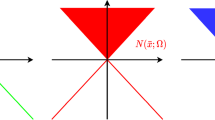Abstract
The simplex algorithm for linear programming is based on the well-known equivalence between the problem of maximizing a linear functionf on a polyhedronP and the problem of maximizingf over the setV P of all vertices ofP. The equivalence between these two problems is also exploited by some methods for maximizing a convex or quasi-convex function on a polyhedron.
In this paper we determine some very general conditions under which the problem of maximizingf overP is equivalent, in some sense, to the problem of maximizingf overV P . In particular, we show that these two problems are equivalent whenf is convex or quasi-convex on all the line segments contained inP and parallel to some edge ofP.
In the case whereP is a box our results extend a well-known result of Rosenberg for 0–1 problems. Furthermore, whenP is a box or a simplex, we determine some classes of functions that can be maximized in polynomial time overP.
Similar content being viewed by others
References
M. Avriel, W.E. Diewert, S. Schaible and I. Zang,Generalized concavity (Plenum, New York, 1988).
A. Brondsted,An Introduction to Convex Polytopes (Springer, Berlin, 1983).
H.J. Greenberg and W.P. Pierskalla, A review of quasi-convex functions, Oper. Res. 19 (1971) 1553–1570.
M. Groetschel, L. Lovasz and A. Schrijver, The ellipsoid method and its consequences in combinatorial optimization, Combinatorica 1 (1981) 169–197.
W.W. Hager, P.M. Pardalos, I.M. Roussos and H.D. Sahinoglou, Active constraints in optimization, Technical report, Penn State University, Computer Science Department (1988) to appear in JOTA.
P.L. Hammer and S. Rudeanu,Boolean Methods in Operations Research and Related Areas (Springer, Berlin, 1968).
P. Hansen, Methods of nonlinear 0–1 programming, Ann. Discrete Math. 5 (1979) 53–70.
P. Hansen, B. Jaumard and V. Mathon, Constrained nonlinear 0–1 programming, Rutgers Research Report 47-89 (1989).
W.K. Hayman and P.B. KennedySubharmonic Functions, vol. 1 (Academic Press, London, 1976).
K.G. Murty,Linear Programming (Wiley, New York, 1983).
P.M. Pardalos and J.B. Rosen, Methods for global concave minimization: a bibliografic survey, SIAM Rev. 18 (1986) 367–379.
R.T. Rockafellar,Convex Analysis (Princeton University Press, Princeton, 1970).
I. Rosenberg, 0–1 optimization and nonlinear programming, Rev. Française Inform. Recherche Operationelle 6 (1972) 95–97.
D.M. Topkis, Minimizing a submodular function on a lattice. Oper. Res. 26 (1978) 305–321.
Author information
Authors and Affiliations
Additional information
This paper has been partially written while the author was visiting the Rutgers Center for Operations Research (RUTCOR). The support of the Air Force grants AFORS-89-0512 and AFORS-90-0008 is gratefully acknowledged.
Rights and permissions
About this article
Cite this article
Tardella, F. On the equivalence between some discrete and continuous optimization problems. Ann Oper Res 25, 291–300 (1990). https://doi.org/10.1007/BF02283701
Issue Date:
DOI: https://doi.org/10.1007/BF02283701




